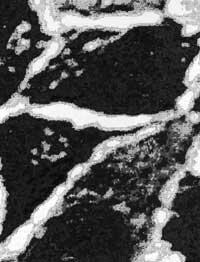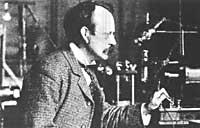X-ray laser
1993/06/01 Alargunsoro, F. Iturria: Elhuyar aldizkaria
If you want to see an object you have to illuminate it. But light, the visible light, is an electromagnetic radiation of certain wavelengths and no objects smaller than those wavelengths are visible. More or less similar to what happens with the pencil to a cartoonist. If you want to draw a house on paper, it is mandatory that the size of the house on paper is larger than the tip of the pencil. No house less than the thickness of the tip of this pencil can draw on the paper with this tool.
Types of radiation

The wavelength of visible light is usually about 10-6 and 10-7 meters, that is, one thousandth of the millimeter. Therefore, no object smaller than this size can be seen with visible light radiation. To do this, physicists have so far used ultraviolet radiation lasers, as they are shorter wavelengths, but when you want to see human and animal cells, ultraviolet radiation also have a too large wavelength. However, below the wavelength of 1.5x10 -7 m (or 1.500 eltngström), there are significant laser manufacturing problems in the field of X-rays and gamma rays. If they are all electromagnetic radiations (they only have a different wavelength), why are there those barriers?
Atomic physics must be used to clarify it. Light is formed by photons emitting atoms when they have undergone energetic changes. The key is in the electrons that revolve around the core. When the atom is in its fundamental energy state, electrons circulate quietly in its orbit. However, when the atom is excited, electrons receive energy and the higher the energy received, the greater the orbit. Once the excitation of the atom is finished, the electrons descend to an orbit of less energy, emitting photons. The wavelength of the emission depends on the initial and final orbits of the electrons.
Laser base
In sunlight or candle, photons extend in all directions and at different wavelengths. The laser mechanism is basically the same, but the emission of photons is unidirectional and of a single wavelength.
To understand better, let's make a comparison. We think that electrons are bullets and orbits are steps of a noisy staircase. Photons will be the noise produced by bullets when climbing the steps, each with a certain tone. If the bullets are thrown at random by the landing, there will be a weak sound with many notes. But if all the bullets are launched at once and at one level, the note corresponding to that level will be strongly heard.
That's what the laser does. Physicists take advantage of a tendency of electrons, because in some conditions they tend to go to energy levels. What must be done is to create these conditions.
Through an external source of radiation, many atoms of a body (may be solid, liquid, or gas) will be placed in the same state of excitement. This operation is called “optical pumping” and when the excited atoms form the majority, physicists say there has been a “population investment”. This initiates the laser effect.
The photon emitted by an atom of the excited population has great chances of colliding with another excited atom. The latter “misses” by emitting the energy of the attacker and the photon of the same direction. This photon does the same as the previous one. Therefore, a set of reactions will immediately amplify the radiation produced. The mechanism that reaches a high intensity is the optical cavity. It has two parallel mirrors to send photons to the place where the laser effect occurs. In this way, the radiation is amplified in each advance of the photons and escapes through a small slot located in one of the mirrors.
This photon flow differs markedly from the flow emitted by the incandescent electric lamp thread. In the lamp the light excels in all directions and for a certain amount of energy the intensity is less as the filament thickens. On the contrary, the laser flow is directed towards the inside of a very narrow cone, and also, the longer the body in which the laser is generated (or more regression of the photons), the greater the intensity. Photons are of the same energy level (or wavelength).
X-ray difficulties

This general laser scheme is easily performed in visible light or ultraviolet radiation, but so far it has been impossible to perform an x-ray laser. One of the reasons has been the absence of mirrors capable of reflecting X-rays, but it is also a more serious obstacle. A physical law indicates that the lower the wavelength of the radiation, the greater the emission itself. For example, if the wavelength is ten times lower, the emission itself is a thousand times higher. Therefore, the excited radiation is immersed in numerous naturally emitted photons and the x-ray laser cannot be separated from this mixed radiation. So, is there no solution for X-ray laser?
We return to the base of the aforementioned laser. We have to generate a special “population investment” and very excited atoms have to go down from one level of determined energy to another to emit X-rays. It was demonstrated that theoretically it is possible in the mid-1970s, but in practice it has only been achieved halfway, since the life of the necessary excitation levels is very short (equivalent to the trillion of a second or to the picoseconds, 10 -12 s approximately). In visible light, on the contrary, the life of excitation levels is around forty nanoseconds (10 -9 seconds), increasing the time as the wavelength of radiation increases.
Physicists have big problems getting X-ray excitations in atoms. If they took advantage of optical pumping, the light source would evaporate or return because the source used should be very powerful.
The solution can be to use plasma. When the material is in plasma state, its atoms are so excited that they lose some (or all) of the electronic cloud. These plasmas, when very hot, that is, very excited, actually emit x-ray radiation. In addition, atoms are heated and cooled very quickly and in plasma there are plenty of swirls, pressures and depressions. Consequently, population investments could be generated spontaneously.
However, some x-ray laser sessions have been performed in some laboratories in recent years. In North America, Livermore laboratories were Denis Matthews and Szimon Suckewer of Princenton, for the first time, the target, and physicist Pierre Jeagle at the University of Orsay in France. X-ray lasers with wavelengths between 43.2 and 200 <unk> gström have been used.
X-ray creation
There are two ways to produce X-rays. The first uses collisions between free electrons and plasma ions. Shock excites the ion and some of its electrons pass into a larger orbit. Then they are “excited”, but the electrons return to the lowest possible orbit. In this way X photons are released from certain energy and direction, that is, a laser beam is formed. In the Livermore laboratory they have the Nova laser, the highest in the world. Denis Mathewsen uses two rays of this laser, 20,000 million kilowatts. To the atoms of Selenium the Nova laser removes 24 of the 34 electrons and leaves them with 10 (because the neon also has 10 electrons is said to be similar to the neons). In the French Limeil (Val-de-Marne) they use the Phebus laser of the Atomic Energy Commission to touch the selenium atoms.
The team of Szimon Suckewer of Princenton, the Rutherford laboratory of England and the team of Pierre Jeagle of Orsay of France, use another phenomenon called “recombination”. Electrons fall into plasma nuclei (atoms recombinate) when cooled by laser shock. Thus, the upper levels of the staircase initially mentioned are filled before the lower ones, generating a population investment at the base of the laser phenomenon. Szimon Suckewer directs the beam to the carbon atom and leaves it with a single electron (like hydrogen). Pierre Jeagle works with aluminum atoms and leaves only three electrons (like lithium). This is the cheapest way, since the electrons that are more attached to the core and that costs the most extraction are deposited in it.
According to Pierre Jeagle, if the shock technique in X-ray lasers advances, it will be very expensive and a very heavy instrument. But if the recombination path continues, X-ray lasers will be obtained using much less power, will be much cheaper and finally can be used in any laboratory.
| Wavelength/m | frequency/kHz | |
10 -13 – | gamma rays | – 10 19 – 10 18 – 10 17 – 10 17 – 10 16 – 10 15 – 10 15 – 10 15 – 10 14 – 10 13 – 10 – 10 – 10 – 10 – 10 9 – 10 8 – 10 7 – 10 5 – 10 5 – 10 4 – 10 3 – 10 2 – 10 – 10 – 1 |

Gai honi buruzko eduki gehiago
Elhuyarrek garatutako teknologia




